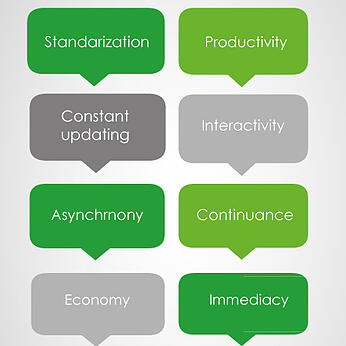An effective eLearning product that’s developed with instructional design’s best practices in mind can help a company obtain a successful learning process, therefore justifying your investment.
Nonetheless, eLearning has several tangible advantages that increase the effectiveness of your investment. These advantages are:
 1. Standardization: All users, regardless of the time and place in which they’re trained, have access to quality content. This helps prevent the loss of information from one course to the other, guarantying that the training’s consistent. A company can see significant savings when they know and have control over the different content provided.
1. Standardization: All users, regardless of the time and place in which they’re trained, have access to quality content. This helps prevent the loss of information from one course to the other, guarantying that the training’s consistent. A company can see significant savings when they know and have control over the different content provided.
2. Updates: A course can be easily modified and it can also adapt itself to changes in content in a short amount of time (years, months and even weeks). Courses in this modality have a life and a technical support attached to it which allows you to update them easily turning your investment into something that’s current and effective.
3. Immediacy:Once the course is developed and placed in a distribution platform (LMS) it will be available right away. Those people who have been assigned to the course can have it available for them immediately. They can even transform it into a daily consultancy tool.
4. Interactivity: The user of an eLearning course it’s not a passive human being that likes to receive information, it is someone that likes to practice, analyze data and perform tasks. Also if they’re provided with a virtual platform or Learning Management System, he or she will be a part of online forums, chats, wikis and workshops among many other options.
5. Asynchrony:With an eLearning course it is not necessary to have a complete shut down when you want to train your staff. You won’t also have to summon the entire company or department at a specific time or outside of the regular work schedule like you would have to for on-site courses. eLearning lets a company arrange their training schedules without intruding in everyday tasks or their workers’ free time. Having eLearning based training is ideal for new collaborators that need high quality, immediate knowledge. It gets rid of the hassle of having to plan an on-site course or having to wait around for more people to join a scheduled training, also there isn’t a need for a tutor to be available throughout the entire process.
6. Continuance:eLearning takes advantage of all multimedia resources available to reinforce the learning process. There’s a better understanding of what’s being taught when a person reads the text, listens to the information, looks at the images that will back it up and practices what has been learned. Also the way its presented lets people learn at their own pace, if they want to go back, review content and go over the exercises again.
7. Economy: An eLearning course can help save costs because there’s no need to relocate people or to have an expert present. Also, there is no need for the instructor to go back and forth among headquarters which helps the company save on travel expenses such as transportation, food, hotels and complimentary material like books, folders, paper, notebooks, etc.
8. Productivity: eLearning can be easily adjusted to your needs. High end, on time training translates into high end workers, whom, with the right motivational tools, will provide optimum performance. This in itself translates into customers or users that are satisfied and will remain loyal to your company guaranteeing its productivity and growth.









